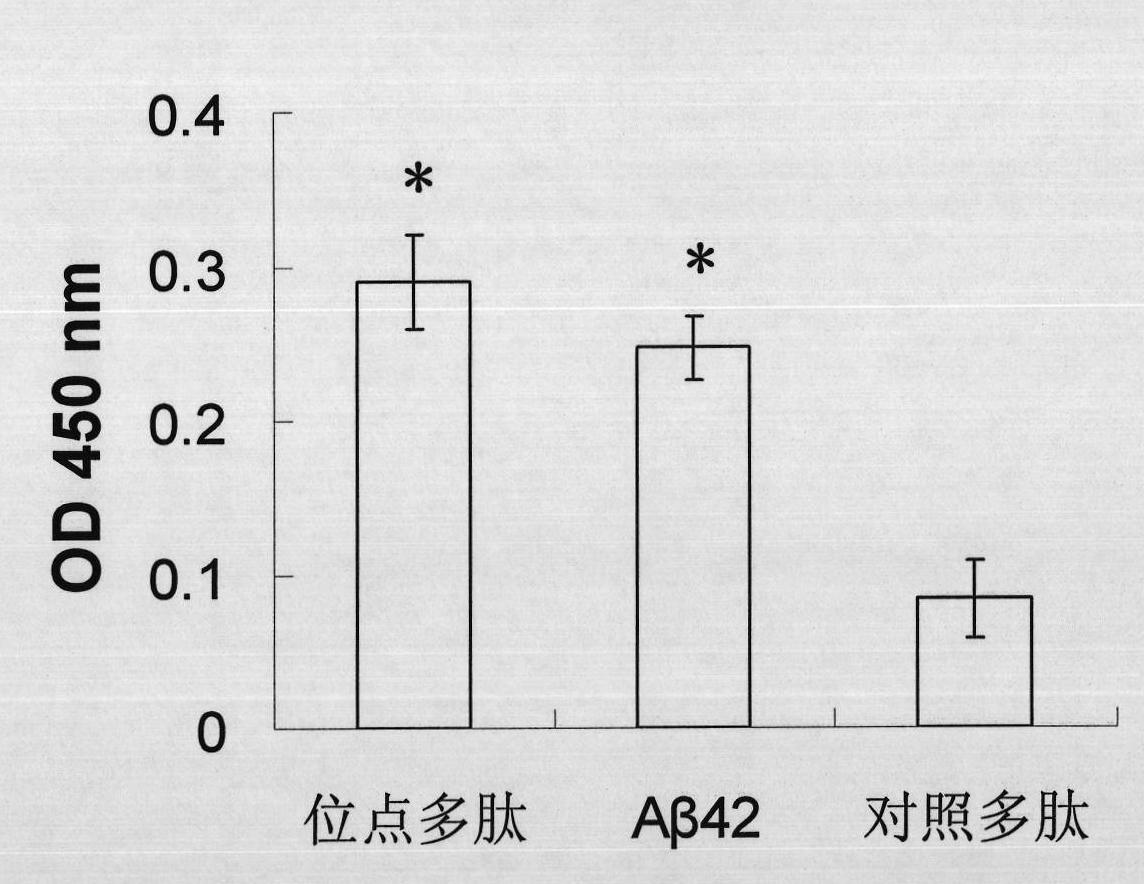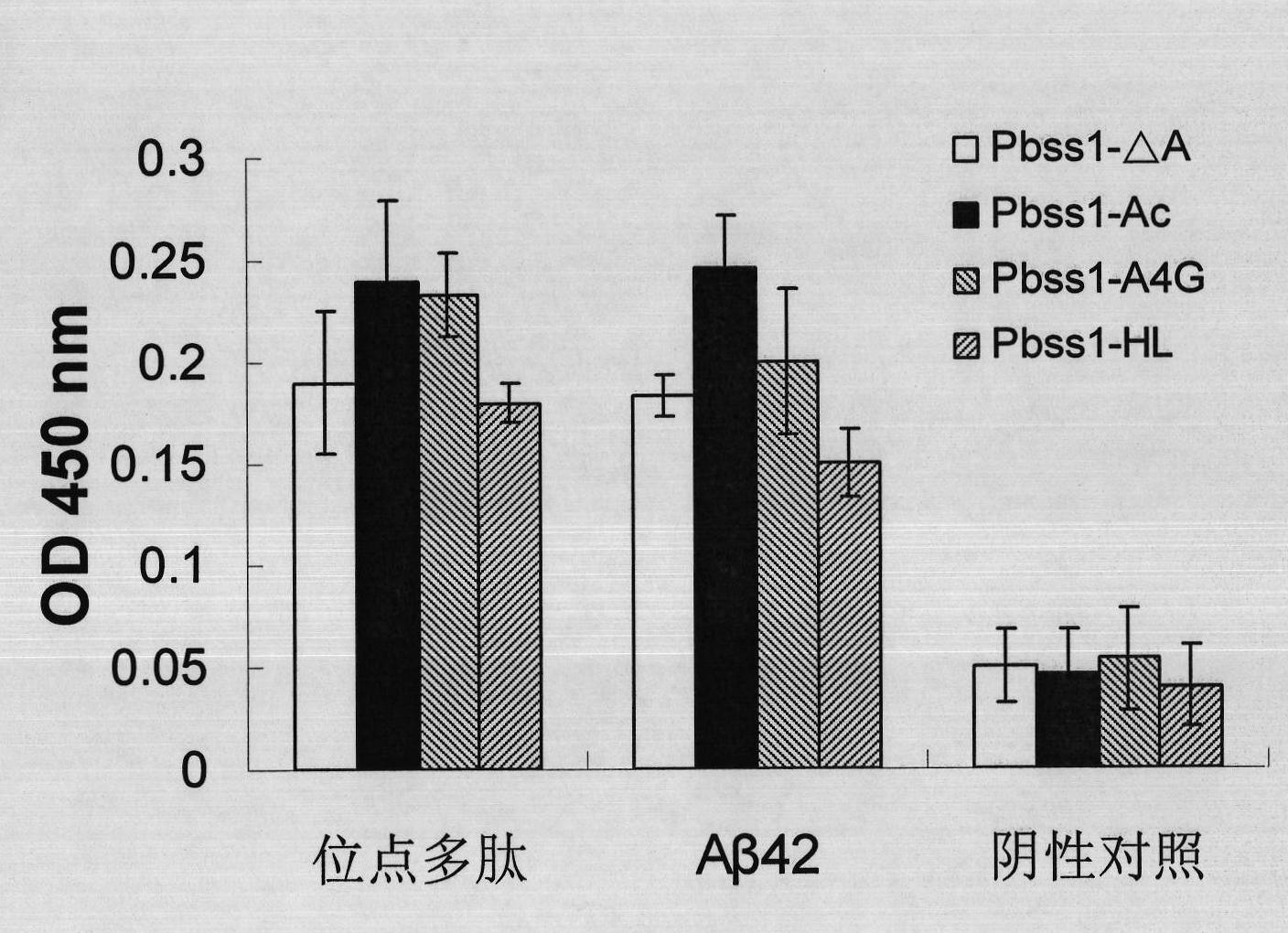Polypeptide for inhibiting enzyme digestion of beta secretase and application thereof
A technology of secretase and secretase inhibitor, which is applied to polypeptides and their application fields in the preparation of drugs for treating Alzheimer's disease, and can solve the problem of easily causing allergic reactions, large specific antibody molecules, and difficult to pass through the blood-brain barrier, etc. problem, to achieve the effect of small molecular weight of polypeptide, small side effects and poor antigenicity
- Summary
- Abstract
- Description
- Claims
- Application Information
AI Technical Summary
Problems solved by technology
Method used
Image
Examples
Embodiment 1
[0033]Example 1. The specific binding of Pbss1 to the β-secretase cleavage site on APP and Aβ42
[0034] The β-secretase cleavage site polypeptide on APP prepared in PBS buffer (Shanghai Jier Polypeptide Co.), Aβ42 (American Peptide Co.) and the negative control polypeptide were coated with 1 μg / well on a 96-well high-affinity microtiter plate, overnight at 4°C. Block the blank site on the microplate plate that is not bound to the polypeptide with BSA, then add 11 μg / well of Pbss linked with 6 histidines as tags, and let it react for 2 hours at room temperature. After washing, the HRP-conjugated antibody capable of binding to the histidine tag was added and reacted at room temperature for 1 h. After washing, the substrate TMB was added, and after 15 minutes of color development, the absorbance at 450 nm was measured with a multifunctional microplate reader.
[0035] Repeated three times under the same conditions, the results are shown in figure 1 , the data in the figure is...
Embodiment 2
[0036] Example 2. Amino acid substitution, deletion or insertion of Pbss1 still binds specifically to the cleavage site of β-secretase of APP and Aβ42
[0037] The N-terminal acetylation of the polypeptide Pbss1 of the present invention, the deletion of alanine (sequence: His-Asp-Pro-Pro-Rrg-Thr), and the replacement of alanine with glycine (sequence: His-Asp-Pro-Pro- Gly-Pro-Rrg-Thr) or insert histidine and connect leucine at the end (sequence: His-Asp-Pro-Ala-His-Pro-Rrg-Thr-Leu), then according to Example 1 The test method detects the specific binding to the β-secretase cleavage site of APP and Aβ42, and uses the ELISA method to measure the OD value. The results are shown in figure 2 . It shows that Pbss1 still retains the ability to simultaneously bind to the β-secretase cleavage site on APP and Aβ42 after certain modifications, certain amino acid substitutions, deletions, or addition of amino acids in the polypeptide (compared with the negative control, P<0.01 ).
Embodiment 3
[0038] Example 3. Pbss1 inhibits the aggregation of Aβ42 in vitro
[0039] 1) Dissolve Aβ42 (American Peptide Company, USA) hexafluoroisopropanol (HFIP) purchased abroad to 1 mg / ml, ultrasonically treat at room temperature for 10 min, dispense into epidorf tubes, volatilize HFIP in vacuum, and then place at -20 Store at ℃. Before use, the HFIP-treated Aβ42 was left at room temperature for 20 min, then dimethyl sulfoxide (DMSO) was added to make the concentration of Aβ42 1 mg / ml, and then diluted to the required concentration with 0.02M PBS buffer at pH 7.4.
[0040] 2) Pbss1 was dissolved in 0.02M PBS buffer at pH 7.4, and then added to the Aβ42 solution so that the final concentration of Aβ42 was 10 μM and the final concentration of Pbss1 was 10 μM and 100 μM. And the Aβ42 solution without Pbss1 was used as the control. All samples were placed at 37°C for 24 hours.
[0041] 3) Thioflavin (ThT) was dissolved in pH 6.5, 50 mM phosphate buffer to a concentration of 5 μM. Tak...
PUM
 Login to View More
Login to View More Abstract
Description
Claims
Application Information
 Login to View More
Login to View More - R&D Engineer
- R&D Manager
- IP Professional
- Industry Leading Data Capabilities
- Powerful AI technology
- Patent DNA Extraction
Browse by: Latest US Patents, China's latest patents, Technical Efficacy Thesaurus, Application Domain, Technology Topic, Popular Technical Reports.
© 2024 PatSnap. All rights reserved.Legal|Privacy policy|Modern Slavery Act Transparency Statement|Sitemap|About US| Contact US: help@patsnap.com










